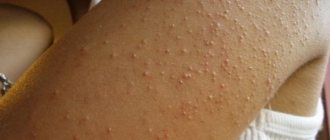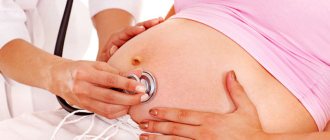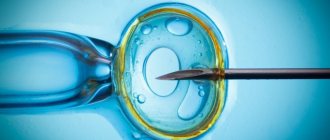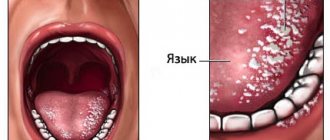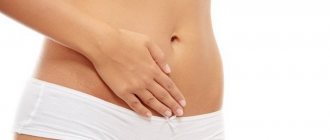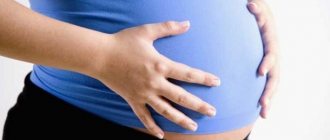Pain in the right hypochondrium during pregnancy
- During pregnancy, metabolism changes significantly, contributing to the formation of stones.
- Expectant mothers have reduced tone of all smooth muscle organs. This includes not only the uterus, but also the walls of all abdominal organs - including the gallbladder. Such hypotonicity interferes with the normal outflow of bile and contributes to the formation of stones.
- The growing uterus mechanically compresses the lower surface of the liver and bile ducts. This also contributes to stagnation of bile and inflammation of the bladder.
How to relieve pain yourself
When pain occurs in the right side during pregnancy, it is important to correctly assess the symptoms.
If the pain is weak, aching and clearly of physiological origin, it is important to calm down, lie down comfortably and find a position in which the pain decreases.
Remember what you ate the day before, how long ago you last went to the toilet, what preceded the onset of painful sensations. If the pain does not go away, be sure to seek help.
If she quiets down and never returns, pay attention to your regimen. Get more rest, walk in the fresh air, balance your diet, and choose foods that do not cause constipation. Reduce fluid intake and wear a bandage. The most important thing is to be positive and calm.
Take any medications strictly as prescribed by your doctor. Do not self-medicate, be careful with traditional medicine recipes, be especially careful when handling a heating pad, as it worsens the condition for many diseases.
If the symptoms indicate emergency care, then while waiting for the doctor to arrive, take the most comfortable position. Let fresh air into the room, drink water, try to calm down and not panic. This is important not only for you, but also for the baby, who feels any mother’s worries.
Symphysiopathy – what is it and how to treat it?
When talking about the pain a woman has to endure after childbirth, we cannot fail to mention the pubic joint. It is the pubic bone that often begins to hurt for many people during pregnancy. And these painful sensations do not leave some even after childbirth.
The symphysis is the connection of the pelvic bones in front. It consists of cartilage and ligaments. During pregnancy, the pubic joint withstands enormous loads. Sometimes the joint is very stretched. The process of childbirth itself contributes to this. Women with a narrow pelvis and a large fetus are especially susceptible to this. The ligaments of the symphysis are not very elastic, so the recovery process is extremely slow.
It is impossible to cure symphysiopathy. Recovery usually occurs over time. A doctor can only help reduce symptoms and relieve severe pain syndromes. Sometimes symptoms of symphysiopathy appear after several years, for example, with increased physical activity. Sometimes pain in the pubic joint occurs as a result of wearing high-heeled shoes, uncomfortable positions (for example, during yoga), injuries, or cycling. This can be quite unpleasant and painful, but it has virtually no effect on your overall health.
If a woman continues to have pain in her pubic bone after childbirth, she is recommended:
- regularly taking medications with calcium, magnesium and vitamin D;
- consumption of foods containing calcium and magnesium;
- daily sunbathing or walking outdoors;
- change body position every half hour;
- reduction of physical activity;
- wearing special bandages (prenatal and postnatal);
- taking acupuncture courses;
- massage;
- electrophoresis;
- Ural Federal District.
Duration of the postpartum recovery period
The recovery time for the body varies from person to person. The return of organs and systems to functionality in the usual prenatal mode occurs in 40–60 days. Complete recovery, including normalization of hormonal levels and the menstrual cycle, skin, hair and nails, occurs within 6–12 months. The likelihood of a new conception reaches its peak after breastfeeding ends.
The period of restructuring of the body increases during the course of chronic diseases, complications during pregnancy and childbirth, and cesarean section.
Involution of the uterus occurs over 8–10 weeks. This period is accompanied by pain.
Discomfort intensifies when the baby is put to the breast. This is due to the increase in the hormone oxytocin with each feeding, which stimulates uterine contractions. An increase in muscle tone after childbirth is required for the rapid reduction of the organ, the release of lochia - blood clots and endometrium. Women confuse uterine pain with pain in the ovary, but in the early stages, discomfort is usually present in the uterus.
In the absence of lactation, the functionality of the appendages resumes 1.5 months after birth. While breastfeeding, they are in a “sleeping” mode, not producing eggs.
The first menstruation during lactation occurs after 6–8 months; their absence for a year is considered normal. Most often, they begin when the baby is introduced to adult food - this reduces milk production and reduces the level of the hormone prolactin. The latter prevents the resumption of ovarian function during breastfeeding, stopping the development of eggs.
During lactation, there is a possibility of conception even in the absence of menstruation, so nursing mothers need to use contraception.
If the pregnancy is not normal
You've probably heard that pregnancy may not always be normal. Unfortunately, it happens that the fetus develops not in the uterus, but in another organ, for example, in the fallopian tube. And in this case we are talking about an ectopic pregnancy.
Often a woman does not even suspect that she has such a problem. She simply states that during her period she experiences severe pain in her lower abdomen.
In fact, these are not periods, but spotting. The cutting pain is sudden and often occurs when walking. You urgently need to see a doctor, he will refer you for an ultrasound, where the pathology will be determined. Next is the operation. Another pathology that leads to pain is cyst rupture.
Symptoms may include:
- heat;
- frequent urination.
There may be headache and nausea. And again an ultrasound is prescribed; if a cyst is detected, it is promptly removed. If the mother is pregnant, then this does not affect the child in any way. I note that if your side constantly hurts, then you don’t need to endure it.
Be sure to tell your doctor about your symptoms. If discomfort is felt at night, then call an ambulance. The main thing is to remain calm and reasonable.
Average recovery time for the body after childbirth
According to most domestic and foreign authors, a young mother usually needs from 6 to 10 weeks to fully recover after the birth of a child. The duration of this period depends on how the pregnancy progressed and whether there were any complications during childbirth.
If the patient has undergone a cesarean section, the period of involution may be longer. Even sick leave for such wards of gynecologists who have suffered a pathological birth is given for a significantly larger number of days.
The reverse process occurs in almost all organs of a woman, excluding the mammary glands and the hormonal system. This is due to the fact that the woman’s body is being rebuilt for successful feeding.
First of all, such a restructuring concerns the patient’s internal genital organs, especially the uterus. Over the course of 7–8 weeks, the female reproductive organ decreases in size by almost 10 times, which cannot but affect the mother’s well-being.
Often during this period, girls complain of pain in the pelvic area of varying intensity, which intensifies while feeding the baby. Many patients believe that it is the ovaries that hurt, however, they are mistaken. Most often, painful sensations are caused by the hormone oxytocin, which not only stimulates lactation, but also increases contractions in the postpartum uterus.
The speed of normalization of ovarian function directly depends on the woman’s hormonal background, with the main condition being whether the mother is breastfeeding or not. If the child is bottle-fed, then restoration of normal ovarian function is possible within 30 to 45 days.
It's another matter if a woman is breastfeeding her baby. Due to the influence of hormones that increase milk secretion, the ovaries can return to their normal state only after 6 - 7 months. Of course, such figures are approximate, since the recovery time of the female body after childbirth is purely individual.
We recommend reading the article about cysts after childbirth. From it you will learn about the causes of pathology, symptoms and diagnosis, treatment methods.
And here is more information about diseases after childbirth.
When a doctor's help is needed
If the ovary hurts a month or two after childbirth, this is not a sign of pathology. This is how the body recovers. Discomfort should not reduce a woman’s performance or negatively affect her well-being. Such pains are almost imperceptible, but are constantly present.
Persistent pain syndrome, its intensification, and the absence of a decrease in intensity during the recovery of the body require a visit to the doctor. This is a sign that the ovaries hurt after childbirth due to the development of a pathological process in them.
Symptoms that require visiting a doctor:
- intense pain in the ovaries of an acute, dull or aching nature,
- the presence of pathological vaginal discharge,
- increase in body temperature,
- intermenstrual uterine bleeding,
- the occurrence of pain later than 2 months after birth, lasting more than a week,
- prolonged presence of lochia.
An increase in body temperature in the first weeks after birth indicates the presence of an acute inflammatory process in the uterus or ovaries.
Heaviness under the left rib
How can this be dangerous and is it the pancreas or spleen?? A dull aching pain under the left rib, localized in the front central part of the abdomen, may be a signal of gastritis or a stomach ulcer. A number of diseases enlarge the spleen, which causes pain under the left rib. Pain that occurs under the left rib from behind can be a symptom of renal pathologies, as well as osteochondrosis of the spine.
I bought imported strawberries, some kind of white inside and odorless, ate it and now I have been suffering with pain and heaviness in my left hypochondrium for four days. The feeling described by someone above that something is in the way under the ribs and is rolling around is also present. My left rib hurts in the same way as many people have written here. The pain is sometimes pressing, sometimes burning. The pain also radiates to the back in the same place. I did an ultrasound, FGDS, and an x-ray of the stomach. And the pain intensifies. The same thing has been happening to me for about a month. I feel heavy.
When I look in the mirror, the increase is very obvious. Especially when I'm squeezing my stomach. The rib sticks out strongly. The same situation on the left, a little heaviness under the ribs (plus the feeling of a bubble when you rub it with your hand) sometimes disappears, sometimes the heaviness returns. The reason for this, I think, is periodic weakness (feeling of rottenness) in the left side under the ribs.
It hurts under the left rib, what could it be?
Everyone’s symptoms are similar, for several months now my left side has been dragging, as if something is bothering me, I want to press it with my hand, it’s scary that it could be a tumor…. It’s the same with the left hypochondrium; doctors can’t find anything or don’t want to. You can check for skin diseases, the same nonsense bothered me, I had dermatitis. The dermatitis went away and the pain in the left hypochondrium went away. That there is not a single folk remedy for this disease, under the left rib.
Discomfort under the left rib.
Symptoms are like everyone else, especially the pain appears in the evening, radiates in
Source


